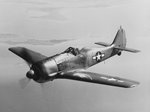*SkyChimp*
Airman
- 36
- Jan 7, 2018
Well, Grumman was impressed enough with the Fw-190 that it was considered in the developement of the F8F Bearcat. Grumman engineers studied and flew the exact Fw that was used in that test.
With respect to the argument that the F6F Hellcat couldn't compete over Europe. It's a rather academic assertion, as it wasn't intended to compete over Europe. It was intended to compete well out to sea where it had to rely on carriers for a place to land. Out over the pacific, the Fw190, as it was, would not have been able to compete with the F6F.
Add to, or replace, all the stuff on a Fw190 so as to make it a sutiable aircraft out in the middle of the Pacific, and you would get a plane that would be better than it was in some categories (wing loading, stall characterisitics, etc) and worse in some (climb, speed, etc.). They would be much more equal.
To be better than either, you'd have to design a new plane, taking the best of both - F8F Bearcat.
With respect to the argument that the F6F Hellcat couldn't compete over Europe. It's a rather academic assertion, as it wasn't intended to compete over Europe. It was intended to compete well out to sea where it had to rely on carriers for a place to land. Out over the pacific, the Fw190, as it was, would not have been able to compete with the F6F.
Add to, or replace, all the stuff on a Fw190 so as to make it a sutiable aircraft out in the middle of the Pacific, and you would get a plane that would be better than it was in some categories (wing loading, stall characterisitics, etc) and worse in some (climb, speed, etc.). They would be much more equal.
To be better than either, you'd have to design a new plane, taking the best of both - F8F Bearcat.


